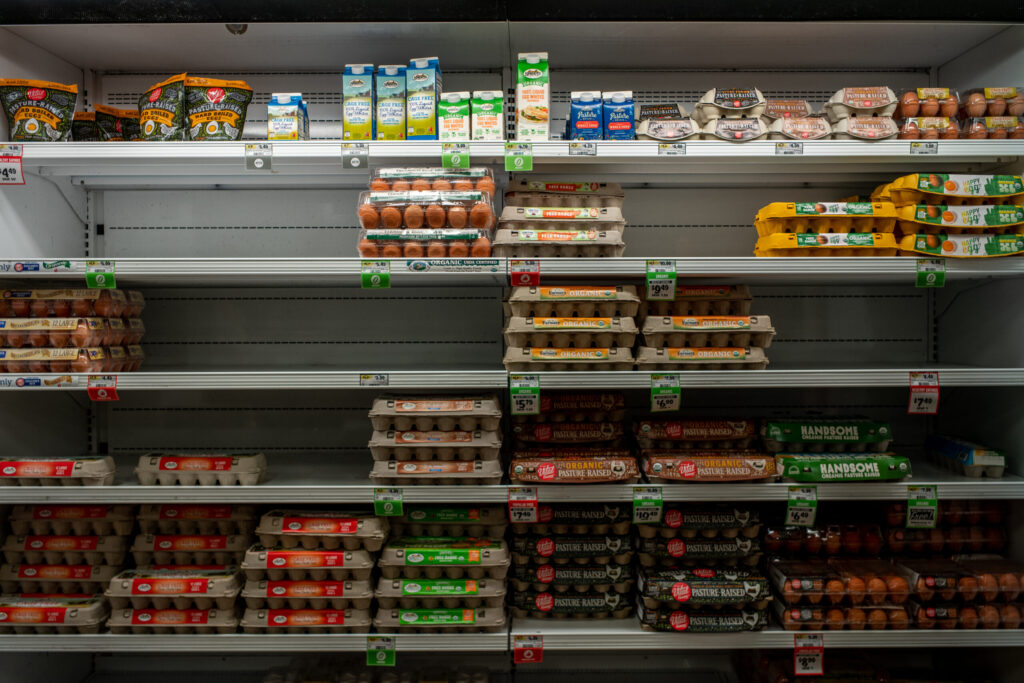Experts expect consumers are weeks away from feeling the impact of the dockworkers’ strike at ports from Texas to Maine. Perishable groceries likely will be the first things where the public might see shortages or price increases. (Brandon Bell | Getty Images)
Anyone swarming Target’s toilet paper aisle or queuing at Costco to buy paper towels because they fear shortages related to dockworkers’ ongoing strike, you can stand down.
Supply chain experts say the work stoppage, which started Tuesday at ports from Texas to Maine, isn’t expected to impact the availability or prices of everyday goods for a few weeks — especially because many businesses have over-ordered products in anticipation of a strike.
“General consumer goods/retail items are actually least likely to see immediate impacts, as retailers and importers have roughly three to four weeks of inventory stockpiled, so any disruptions would occur only if the strike lasted longer than this,” said Jena Santoro, senior manager of global risk intelligence at Everstream Analytics.
And even then, the market still has many modes of transportation serving it, said David Dreyfus, an associate professor in Rutgers University’s Department of Supply Chain Management.
The West Coast ports remain open, shipping lines with Mexico and Canada continue functioning as usual, and companies that rely on ports now idle because of the strike will start looking for alternative routes like rail and air, he noted.
“We’re all a little still getting over the pandemic, and we remember what that was like,” Dreyfus said. “But this isn’t the pandemic. The logging hasn’t stopped. The mills haven’t stopped running. The trucks and trains are still running. They’re humming along. It’s just one mode of transportation has stopped — and only decreased by a certain percentage; it hasn’t completely stopped. So while things may be slow and there might be some temporary shortages, it’s not going to be like we saw a few years ago.”
Transportation costs could rise as cargo hops to other modes of transportation — and that usually gets passed on to consumers, he said.
“But that doesn’t impact consumers directly right away,” he added.
Santoro and Dreyfus agreed perishable groceries likely will be the first product the public will see vanish or spike in price because stores can only stockpile lettuce and bananas so much.
“So in that area, we could see some price increases, some shortages, within a couple of weeks,” Dreyfus said.
Santoro predicted shortages also could come sooner for pharmaceuticals and specialized cargo like automotive components because those sectors rely on a time-sensitive supply chain and consequently tend to stockpile about half the inventory of other sectors.
Anticipating that some unscrupulous companies could try to cash in on shortages, Gov. Phil Murphy, along with New York Gov. Kathy Hochul, Maryland Gov. Wes Moore, and Massachusetts Gov. Maura Healey, issued a joint statement Thursday warning companies that they are closely monitoring for price-gouging.
“(We) warn all companies that they should not use this moment as an opportunity to unfairly profit off of working families,” the governors said. “We will continue to closely coordinate to ensure that critical supplies are available at medical facilities and grocers across the country.”
Backlogs expected
East and Gulf Coast ports process nearly half of the country’s cargo, Santoro said. The Port of New York and New Jersey is the busiest port on the East Coast and the third-largest in the country.
Every 24-hour shutdown of all East and Gulf Coast ports results in operational backlogs that could take up to seven days to clear, according to historic congestion and strike data for U.S. ports analyzed by Everstream Analytics. That means a weeklong strike would have repercussions until after the U.S. presidential election.
But it’s tough to predict how long the strike could go on, Dreyfus said.
“Right now, they seem very at odds, the negotiating teams, about what they’re asking for and what they’re willing to concede on,” he said. “So it’s anybody’s guess right now how long it may last.”
The federal government could order the dockworkers back to work if authorities determine the strike is intolerably paralyzing the supply chain, Dreyfus said.
Without such intervention, a lingering strike and its compounding effects of displaced containers and equipment, disrupted schedules, and vessel diversions could impact consumers past Thanksgiving and potentially into December, according to Everstream Analytics projections.
But Dreyfus had a reminder for any panic-prone consumers thinking of heading to the store to start stockpiling — this is the Garden State.
“If I am unable to get a few fruits one week or a lettuce that I may have wanted, I can go to my local farm and get some apples and other things,” he said. “So I think there will be alternatives, if you can’t find exactly what you want.”
New Jersey Monitor is part of States Newsroom, a nonprofit news network supported by grants and a coalition of donors as a 501c(3) public charity. New Jersey Monitor maintains editorial independence. Contact Editor Terrence T. McDonald for questions: info@newjerseymonitor.com. Follow New Jersey Monitor on Facebook and X.
GET THE MORNING HEADLINES.

